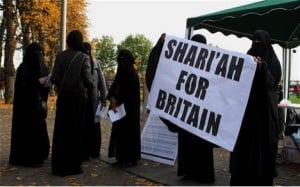 Women suicide bombers have been receiving increasing coverage in the media in recent years. Just this past week, at least three articles have been written about women suicide bombers in Iraq. The coverage of women terrorists in the Western media is often colored by gender expectations and stereotypes of women as well as the usual fear of Muslims.
Women suicide bombers have been receiving increasing coverage in the media in recent years. Just this past week, at least three articles have been written about women suicide bombers in Iraq. The coverage of women terrorists in the Western media is often colored by gender expectations and stereotypes of women as well as the usual fear of Muslims.
One of the most problematic aspects of coverage of women suicide bombers is the focus on personal motivations. News stories about women suicide bombers often focus on revenge for the death of a loved one and dishonor from rape or sex outside (thus, forcing them to become suicide bombers). In fact, the Times article that is linked to in the Friday Links for 7/1/08 is titled ” Love, blackmail and rape – how al-Qaeda grooms women as ‘perfect weapons’”.
Some women suicide bombers are motivated by personal factors and some are coerced. However, there is hardly ever a look at the ideological and political reasons for why women become suicide bombers. I suspect this is because of gender bias. Women are seen as irrational and emotional and the reasons for why they become terrorists are portrayed as irrational and emotional. This is completely different from how male suicide bombers are portrayed. Coverage of male suicide bombers usually does not focus on personal factors and almost exclusively focuses on religion, ideology and politics. Coverage of male suicide bombers focuses on their causes and usually not the bomber himself. This leads to portraying male suicide bombers as having more rational reasons for becoming suicide bombers.*
There’s also the usual focus on clothes. The three articles linked to in this post as well other, older articles almost always focus on Muslim (usually hijabis) women’s dress. The assumption goes that the “robe” (jilbab) that some Muslim women wear allows them to easily conceal bombs and thus makes them very attractive to extremist groups. The picture above is part of a slide show that accompanies a BBC News story about women suicide bombers in Iraq. I guess the focus on hijab is to be expected in just about any news story that focuses on Muslim women. However, I find it troubling that hijab is once again tarnished, albeit more covertly than usual. The “robe” explanation usually segues into the idea that women are attractive to extremist groups because they’re less likely to be searched by male soldiers. All of these reasons and motivations for the rise in women suicide bombers totally take the focus off of political circumstances (which Western nations definitely play a hand in) that also influenced the decision of both male and female suicide bombers.
Additionally, there is little focus on how women suicide bombers challenge gender roles. This does not mean that I endorse suicide bombing. However, women suicide bombers do effectively show that Muslim women can have multifaceted gender roles. Women suicide bombers show that women can be effective in military operations. Additionally, women suicide bombers have actually inspired feminist activism in various parts of the Muslim world including Egypt, Palestine and Saudi Arabia. For instance, protests were held by feminists in all three countries praising the women suicide bombers. During these protests, feminists also demanded more rights for themselves. If women could die for causes like men, shouldn’t they have the same rights as men? Suicide bombings are controversial and I imagine that it is hard for Western media outlets to put any positive “spin” on this issue. However, isn’t it the job of the media to show all sides of a story? This would include showing how women suicide bombers are affecting gender norms in their societies.
*Terri Toles Patkin’s essay “Explosive Baggage: Female Palestinian Suicide Bombers and the Rhetoric of Emotion” further expands on this idea.













